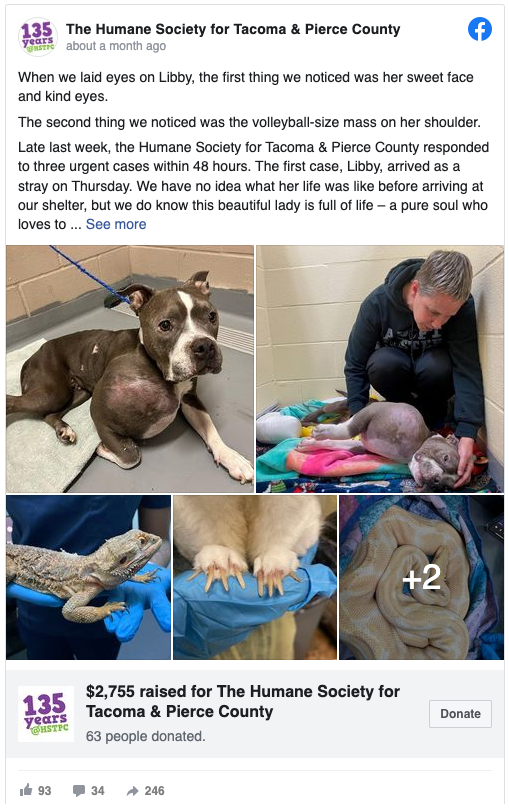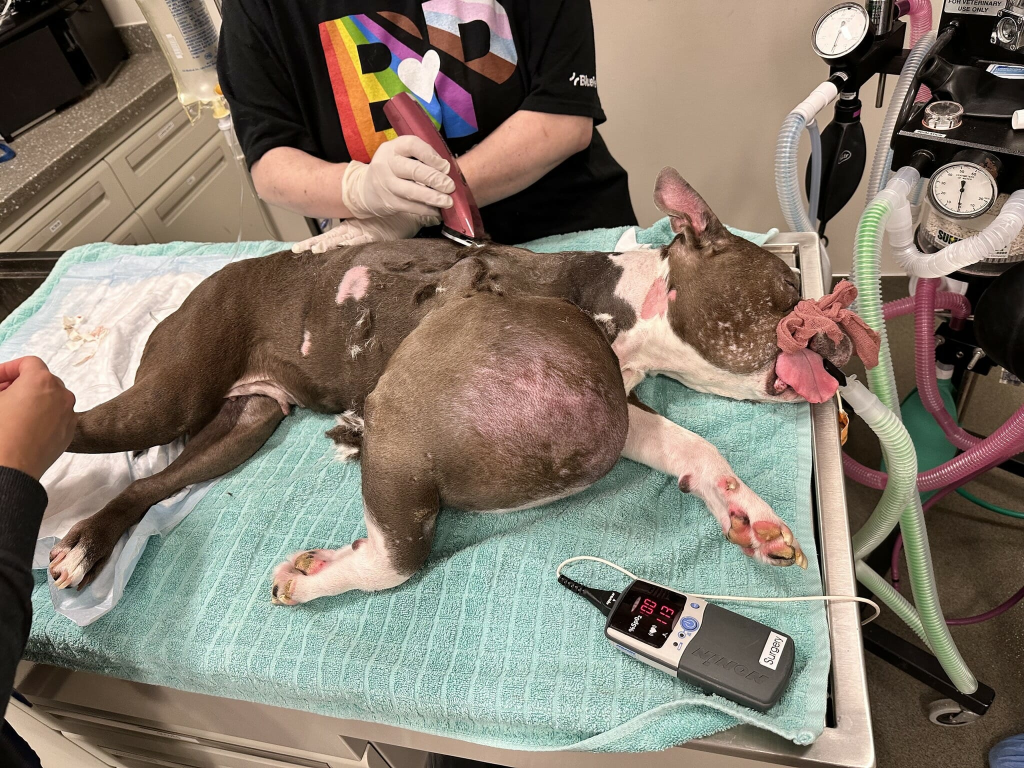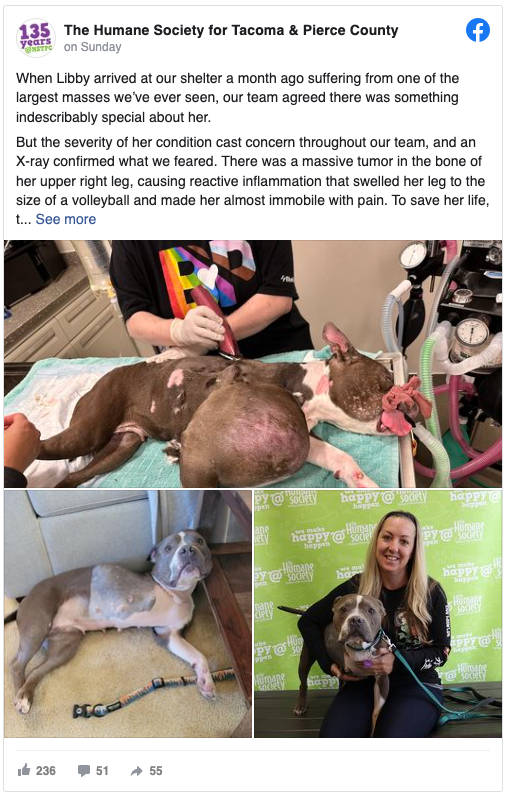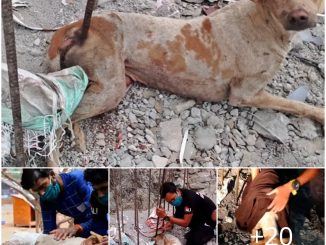Animal shelters do incredible work giving pets a second chance. Some animals arrive at shelters in shocking condition, but they still step up to give them the love and care they need.
That was the case for a dog named Libby, who had a tumor the size of a volleyball. But now, her story has a happy ending.
In August, the Humane Society for Tacoma and Pierce County, in Washington state, took in a stray pit bull named Libby. They said the dog was “full of life” and had a “sweet face and kind eyes.”
However, Libby also had a serious medical concern: a 10-pound tumor the size of a volleyball, one of the largest masses they had ever seen:

Libby arrived at a hectic time for the shelter: HSTPC says Libby was just one of three urgent cases they responded to in 48 hours, and as Washington’s largest-intake shelter dozens of new animals were arriving every day.
Despite that, they resolved to give Libby the best possible care, even though they weren’t sure what the future had in store for the poor dog.
“She deserves the most compassionate care possible, but we don’t know what her outcome will be at this time,” the shelter wrote in August. “Our veterinary team is working on every possible option and will start with testing to understand what kind of tumor Libby has. For now, she is receiving pain medication to ease her discomfort and endless love from our staff.”
After giving Libby an x-ray, they discovered the tumor was in the bone of her upper right leg, and would require amputation. Reactive inflammation caused the tumor to swell to its unusual size, and was causing her agonizing pain.

Through generous donations from supporters, the shelter was able to pay for Libby’s leg amputation. The surgery, done by the vet staff at BluePearl Pet Hospital, was a success and Libby was finally free of the pain she had been living through.
Sadly, even though her tumor was gone, she was diagnosed with aggressive bone cancer, and her time on earth might be limited. But in happy news, Libby has found a home!
According to HSTPC, a vet tech fell in love with Libby and agreed to adopt her. Even though she knows that Libby might not live long, she wanted to fill her remaining days with love.
“There’s something in her eyes that begs for love and safety,” her new adopter said, according to a Facebook post. “I couldn’t turn away from that.”

Libby has now been renamed “Wiggles” and is enjoying her new home, playing with her dog brother and family and taking lots of cozy naps on the couch.
“Though we’re uncertain how much time she has left, we know she’ll spend her remaining days
Saving lovable puppies: A courageous battle against numerous health-threatening parasites to secure a journey towards a joyous and wholesome existence-d6
In a world where the boundless charm of puppies meets the harsh reality of health-threatening parasites, a group of dedicated individuals has embarked on a courageous battle to ensure these lovable companions find their way to a joyous and wholesome existence.

The journey begins with the recognition of the vulnerability of these adorable creatures. Puppies, with their wide-eyed innocence and playful demeanor, often fall prey to a myriad of parasites that threaten their well-being. The guardians, driven by compassion and a deep sense of responsibility, have committed themselves to stand against this invisible menace.
Countless health-threatening parasites lurk in the shadows, ready to compromise the vitality of these innocent beings. From intestinal worms to external pests, the battle encompasses a wide spectrum of challenges. The guardians employ a multi-faceted approach, combining preventive measures, medical interventions, and educational outreach to tackle the issue at its roots.

Preventive measures form a crucial aspect of the guardians’ strategy. They tirelessly work to create awareness among pet owners about the significance of regular veterinary check-ups, vaccinations, and maintaining a clean environment. By empowering the community with knowledge, they aim to build a shield against potential health threats, ensuring that puppies start their lives on a foundation of wellness.
The courageous battle against health-threatening parasites extends beyond awareness. The guardians actively collaborate with veterinary experts, researchers, and pet care professionals to stay ahead of emerging challenges. Through continuous learning and adaptation, they refine their strategies, ensuring the most effective and compassionate care for the puppies under their protection.

Medical interventions play a pivotal role in the guardians’ quest. Each rescued puppy undergoes thorough veterinary assessments, enabling prompt diagnosis and tailored treatment plans. The guardians spare no effort in ensuring that these interventions not only eradicate existing parasites but also prevent future infestations, securing a healthier and happier life for their charges.
Educational outreach emerges as a beacon of hope in the guardians’ mission. They engage with communities, schools, and pet owners, fostering a culture of responsible pet care. By instilling a sense of shared responsibility, they aim to create a ripple effect that extends beyond the immediate rescue efforts, promoting a sustained commitment to the well-being of all puppies.

In the face of adversity, these guardians stand firm, unwavering in their commitment to saving lovable puppies from the clutches of health-threatening parasites. Their journey is not just a battle; it is a testament to the enduring power of compassion and the potential for positive change. Through their collective efforts, a pathway is being forged—a journey towards a joyous and wholesome existence for every puppy, where innocence is preserved, and well-being is paramount.



Leave a Reply